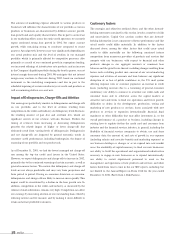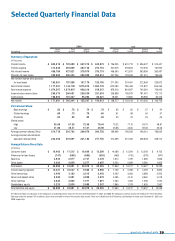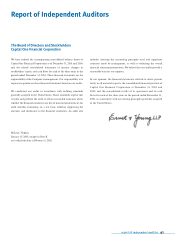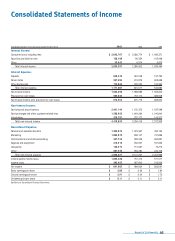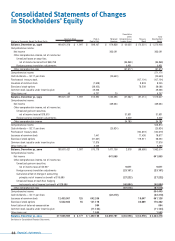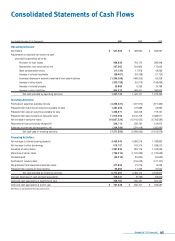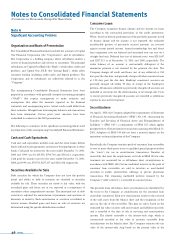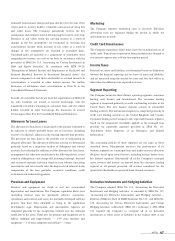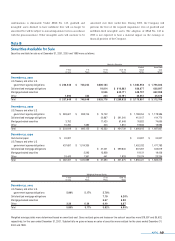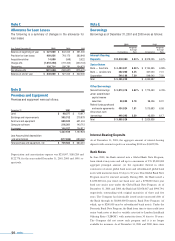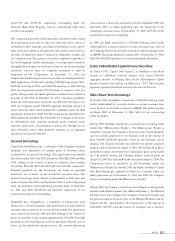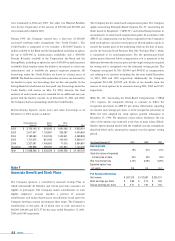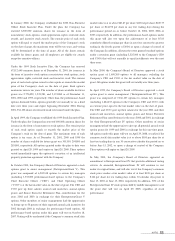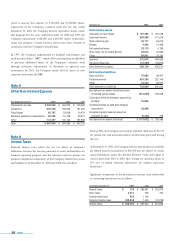Capital One 2001 Annual Report Download - page 49
Download and view the complete annual report
Please find page 49 of the 2001 Capital One annual report below. You can navigate through the pages in the report by either clicking on the pages listed below, or by using the keyword search tool below to find specific information within the annual report.
estimated excess finance charges and past-due fees over the sum of the
return paid to security holders, estimated contractual servicing fees
and credit losses. The Company periodically reviews the key
assumptions and estimates used in determining the interest-only strip.
Decreases in fair values below the carrying amount as a result of
changes in the key assumptions are recognized in servicing and
securitizations income, while increases in fair values as a result of
changes in key assumptions are recorded as unrealized gains.
Unrealized gains are included as a component of cumulative other
comprehensive income, on a net-of-tax basis, in accordance with the
provisions of SFAS No. 115, “Accounting for Certain Investments in
Debt and Equity Securities.” In accordance with EITF 99-20,
“Recognition of Interest Income and Impairment of Purchased and
Retained Beneficial Interests in Securitized Financial Assets,” the
interest component of cash flows attributable to retained interests in
securitizations is recorded in other interest income. See further
discussion of off-balance sheet securitizations in Note N to the
Consolidated Financial Statements.
Tr ansfers of receivables that do not meet the requirements of SFAS 140
for sales treatment are treated as secured borrowings, with the
transferred receivables remaining in consumer loans and the related
liability recorded in other borrowings. See discussion of secured
borrowings in Note E to the Consolidated Financial Statements.
Allowance for Loan Losses
The allowance for loan losses is maintained at the amount estimated to
be sufficient to absorb probable losses, net of recoveries (including
recovery of collateral), inherent in the existing reported loan portfolio.
The provision for loan losses is the periodic cost of maintaining an
adequate allowance. The amount of allowance necessary is determined
primarily based on a migration analysis of delinquent and current
accounts. In evaluating the sufficiency of the allowance for loan losses,
management also takes into consideration the following factors: recent
trends in delinquencies and charge-offs including bankrupt, deceased
and recovered amounts; historical trends in loan volume; forecasting
uncertainties and size of credit risks; the degree of risk inherent in the
composition of the loan portfolio; economic conditions; credit
evaluations and underwriting policies.
Premises and Equipment
Premises and equipment are stated at cost less accumulated
depreciation and amortization. The Company capitalizes direct costs
(including external costs for purchased software, contractors,
consultants and internal staff costs) for internally developed software
projects that have been identified as being in the application
development stage. Depreciation and amortization expenses are
computed generally by the straight-line method over the estimated
useful lives of the assets. Useful lives for premises and equipment are as
follows: buildings and improvements — 5-39 years; furniture and
equipment — 3-10 years;computers and software — 3 years.
Marketing
The Company expenses marketing costs as incurred. Television
advertising costs are expensed during the period in which the
advertisements are aired.
Credit Card Fraud Losses
The Company experiences fraud losses from the unauthorized use of
credit cards. Transactions suspected of being fraudulent are charged to
non-interest expense after a 60-day investigation period.
Income Taxes
Deferred tax assets and liabilities are determined based on differences
between the financial reporting and tax bases of assets and liabilities,
and are measured using the enacted tax rates and laws that will be in
effect when the differences are expected to reverse.
Segment Reporting
The Company maintains three distinct operating segments: consumer
lending, auto finance and international. The consumer lending
segment is comprised primarily of credit card lending activities in the
United States. The auto finance segment consists of automobile
lending activities. The international segment is comprised primarily of
credit card lending activities in the United Kingdom and Canada.
Consumer lending is the Company's only reportable business segment,
based on the quantitative thresholds applied to the managed loan
portfolio for reportable segments provided in SFAS No. 131,
"Disclosures about Segments of an Enterprise and Related
Information."
The accounting policies of these segments are the same as those
described above. Management measures the performance of its
business segments on a managed basis and makes resource allocation
decisions based upon several factors, including income before taxes,
less indirect expenses. Substantially all of the Company's managed
assets, revenue and income are derived from the consumer lending
segment in all periods presented. All revenue considered for the
quantitative thresholds are generated from external customers.
Derivative Instruments and Hedging Activities
The Company adopted SFAS No. 133, “Accounting for Derivative
Instruments and Hedging Activities,” as amended by SFAS No. 137,
“Accounting for Derivative Instruments and Hedging Activities –
Deferral of Effective Date of FASB Statement No. 133,” and SFAS No.
138, “Accounting for Certain Derivative Instruments and Certain
Hedging Activities,” (collectively,“SFAS 133”) on January 1, 2001. SFAS
133 required the Company to recognize all of its derivative
instruments as either assets or liabilities in the balance sheet at fair
notes 47



